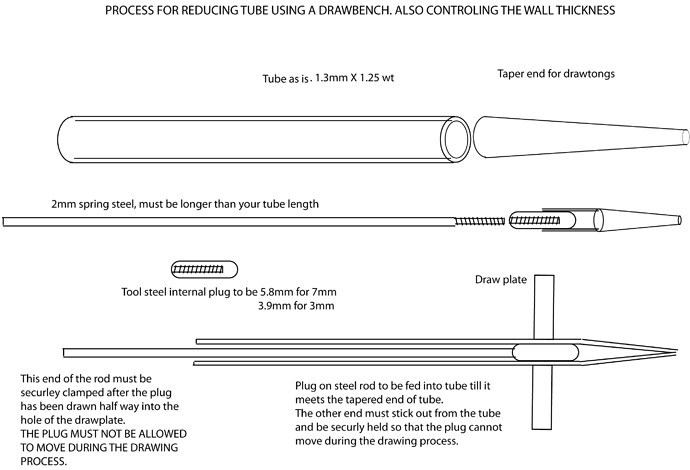Firstly, I will say that it would be better to have tube drawn to
the sizes that you need for your work as this is a difficult process.
I presume you will be doing a lot of work starting
with this size tube to make this a worthwhile process.
Secondly, as you probably know the wall thickness will increase each
time the tube is reduced in diameter, therefor two processes need to
be combined for each drawing.
- The reduction of the external diameter
- The reduction of the wall thickness.
To achieve this duel process it is necessary to:
-
have a very strong drawbench, belt and drawtongs.
-
You will need to have some polished tool steel plugs made,
drilled and threaded, and have some strong high tensile steel 2mm
wire, longer than the tubes length, to be threaded at one end to be
screwed into the polished plugs. The plugs must be highly polished
and lubricated.
I would suggest that you look at your draw plate and count the holes
from the starting hole, that is, the next hole under the 13mm hole
then count down to the 7mm hole, (and the 3mm hole) Assuming there is
a 0.5mm reduction between each hole, that gives 12 stages from 12.5mm
down to 7mm
At a guess I would make 6 polished plugs of decreasing diameter and
use one for each second drawing. It may not be so simple however.
You may have to make more plugs, one for each hole.
Experiment first with a short length of tube.
Process.
-
Anneal tube and taper 25mm + of tube to fit through lubricated
drawplate.
-
Screw the threaded end of the high tensile wire into the largest
polished plug.
-
Insert largest highly polished plug into annealed, lubricated tube
till the largest plug meets the tapered part. Then draw about 2mm of
tube through the hole till you feel the plug is approx held centrally
in the drawplate hole. See illustration.
Secure the other end of the wire so it cannot move as you draw the
tube down.
- Repeat the process changing to the next smaller diameter plug
down for each draw.
As I suggest you may have to make a separately sized plug for each
hole.
Look at the figures for 6 plugs:
External diameter 13mm with wall thickness of 1.25: so that is 13mm
minus 2x 1.25 as there are two X wall thicknesses to be considered,
so, 13-(1.25 + 1.25)=10.5 So the first plug needs to be slightly
smaller say 9.5mm at a guess, and so on. So for 7mm external
diameter your final plug will be 5.8mm for a wall thickness of 0.6
7-(0.6+0.6) = 7-1.2= 5.8
This will require a lot of patience and attention to detail as each
drawing is done.
Best of luck
David
